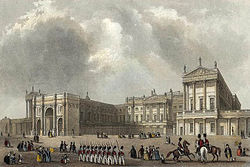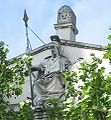- Marble Arch
-
This article is about a landmark in London. For the Marble Arch in Libya, see Marble Arch (Libya).
Coordinates: 51°30′47″N 0°9′32″W / 51.51306°N 0.15889°W
 Marble Arch as originally erected, as a gateway to the newly rebuilt Buckingham Palace.
Marble Arch as originally erected, as a gateway to the newly rebuilt Buckingham Palace.
Marble Arch is a white Carrara marble monument that now stands on a large traffic island at the junction of Oxford Street, Park Lane, and Edgware Road, almost directly opposite Speakers' Corner in Hyde Park in London, England. Until 1851 it stood in front of Buckingham Palace.
Historically, only members of the royal family and the King's Troop, Royal Horse Artillery, have been allowed to pass through the arch in ceremonial procession.[1]
The name "Marble Arch" also refers to the locality in west London where the arch is situated, particularly, the southern portion of Edgware Road. There also is an underground station named after it.
Contents
History
The arch was designed in 1825 by John Nash as ceremonial entrance to the new Buckingham Palace,[2] which he was then rebuilding from the former Buckingham House. At that time the palace did not yet have its present flat east front, which meant that the inner courtyard, flanked by two wings, was still open on one side. The Marble Arch was placed at the entrance to this open side of the courtyard. Sculpture for the arch was commissioned from John Flaxman, Sir Richard Westmacott, Edward Hodges Baily and John Charles Felix Rossi;[2] a bronze equestrian sculpture of George IV by Francis Chantrey was to stand on the top.
Construction began in 1827, but was cut short in 1830 because of rising costs. Work restarted in 1832, this time under the supervision of Edward Blore, who greatly reduced Nash's planned attic stage and omitted its sculpture, including the statue of George IV. The arch was completed in 1833.[2]
The marble soon lost its whiteness in the polluted London atmosphere. In 1847, Sharpe's London Magazine described it as "discoloured by smoke and damp, and in appearance resembling a huge sugar erection in a confectioner's shop window".[3]
In 1851 the arch was moved to its present location,[2] when the new east range of the palace was built, closing in the courtyard. A popular story says that the arch was moved because it was too narrow for the Queen's state coach to pass through, but, in fact, the gold state coach passed under it during Elizabeth II's coronation in 1953.[4]
There are three small rooms inside the rebuilt arch that were used as a police station until 1950, first for the royal constables of the Park and later the Metropolitan Police. One policeman stationed there during the early 1860s was Samuel Parkes, who won the Victoria Cross in the Charge of the Light Brigade in 1854, during the Crimean War.
It has been speculated that the arch might be moved across the street to Hyde Park, or to some other more-accessible location, instead of its current position on a large traffic island.[5]
Design
The design of the arch is based on that of the Arch of Constantine in Rome. The attic storey was originally intended to be considerably taller, and embellished with sculpture:[6] an architectural model, made in around 1826, now in the Victoria and Albert Museum shows it with a continuous relief of the Battle of Waterloo on one side and scenes of naval engagements on the other.[7] In 1829, a bronze equestrian statue of George IV was commissioned from Sir Francis Chantrey, with the intention of placing it on top of the arch. It was instead installed on a plinth in Trafalgar Square.[8]
The friezes intended for the arch were used to decorate Buckingham Palace.[9]Other sculptures originally made for the arch were instead used on the façade of the National Gallery.[10]
Location
Public transport access London Buses Marble Arch
2, 10, 16, 36, 73, 74, 82, 137, 159, 148, 414, 436London Underground Marble Arch The nearest London Underground station is Marble Arch on the Central Line.
The area around the arch forms a major road junction connecting Oxford Street to the east, Park Lane (A4202) to the south, Bayswater Road (A402) to the west, and Edgware Road (A5) to the north-west. The short road directly to the north of the arch is also known as Marble Arch.
The area once was home to the largest cinema screen in London at the Odeon Marble Arch cinema. The screen was originally over 75 feet (23 m) wide. The Odeon showcased 70 mm films in a large circle-and-stalls auditorium. The cinema was converted into a mini-plex in 1997.
The arch is near the largest Marks & Spencer store in the United Kingdom, which opened in 1930.[11]
The arch also stands close to the site of the Tyburn gallows (sometimes called 'Tyburn Tree'), a place of public execution from 1388 until 1793.
Image gallery
-
Britannia, now Minerva, patroness of the arts
References
- ^ The London Encyclopaedia Ben Weinreb and Christopher Hibbert pp. 496 {Macmillan, 1983} ISBN 0333325567
- ^ a b c d "Pastscape-Detailed Result". English Heritage. http://www.pastscape.org.uk/hob.aspx?hob_id=1492760&sort=4&search=all&criteria=Gate%20Burton&rational=q&recordsperpage=10. Retrieved 7 October 2011.
- ^ "A Little Talk About Buckingham Palace". Sharpe's London Magazine 13 (4): 355. 1847.
- ^ "Coronation route". http://www.apts.org.uk/route.jpg. Retrieved 2011-09-21.
- ^ "Marooned Marble Arch may be moved". BBC News. 2005-02-28. http://news.bbc.co.uk/1/hi/england/london/4303919.stm. Retrieved 2011-09-21.
- ^ Timbs, John (1868). London and Westminster: City and Suburb. London. pp. 190-1. http://books.google.co.uk/books?id=lREHAAAAQAAJ&printsec=frontcover. Retrieved 15 July 2011.
- ^ "Architectural Model". Victoria and Albert Museum. http://collections.vam.ac.uk/item/O77788/architectural-model/. Retrieved 15 July 2011.
- ^ Cunningham, Peter (1850). Handbook of London: Past and Present. 1. London: John Murray. p. 511. http://books.google.co.uk/books?id=0BQNAAAAYAAJ&printsec=frontcover. Retrieved 15 July 2011.
- ^ "Buckingham Palace History". The Royal Household. http://www.royal.gov.uk/TheRoyalResidences/BuckinghamPalace/History.aspx. Retrieved 13 October 2011.
- ^ "Sculptures on the building". National Gallery. http://www.nationalgallery.org.uk/paintings/history/sculptures-and-mosaics/sculptures-and-mosaics/*/viewPage/2. Retrieved 7 October 2011.
- ^ "Marks & Spencer Plc - History of the retail company". Examstutor.com. 1907-07-25. http://www.examstutor.com/business/resources/companyprofiles/marksandspencer/history.php?style=printable. Retrieved 2011-09-21.
External links
Categories:- Buildings and structures completed in 1833
- Monuments and memorials in London
- Regency London
- Buildings and structures in Westminster
- Triumphal arches in the United Kingdom
- Road junctions in London
- Streets in Westminster
- Grade I listed buildings in London
- Grade I listed monuments and memorials
- Visitor attractions in London
- Relocated buildings and structures
- Visitor attractions in Westminster
- Terminating vistas
Wikimedia Foundation. 2010.










